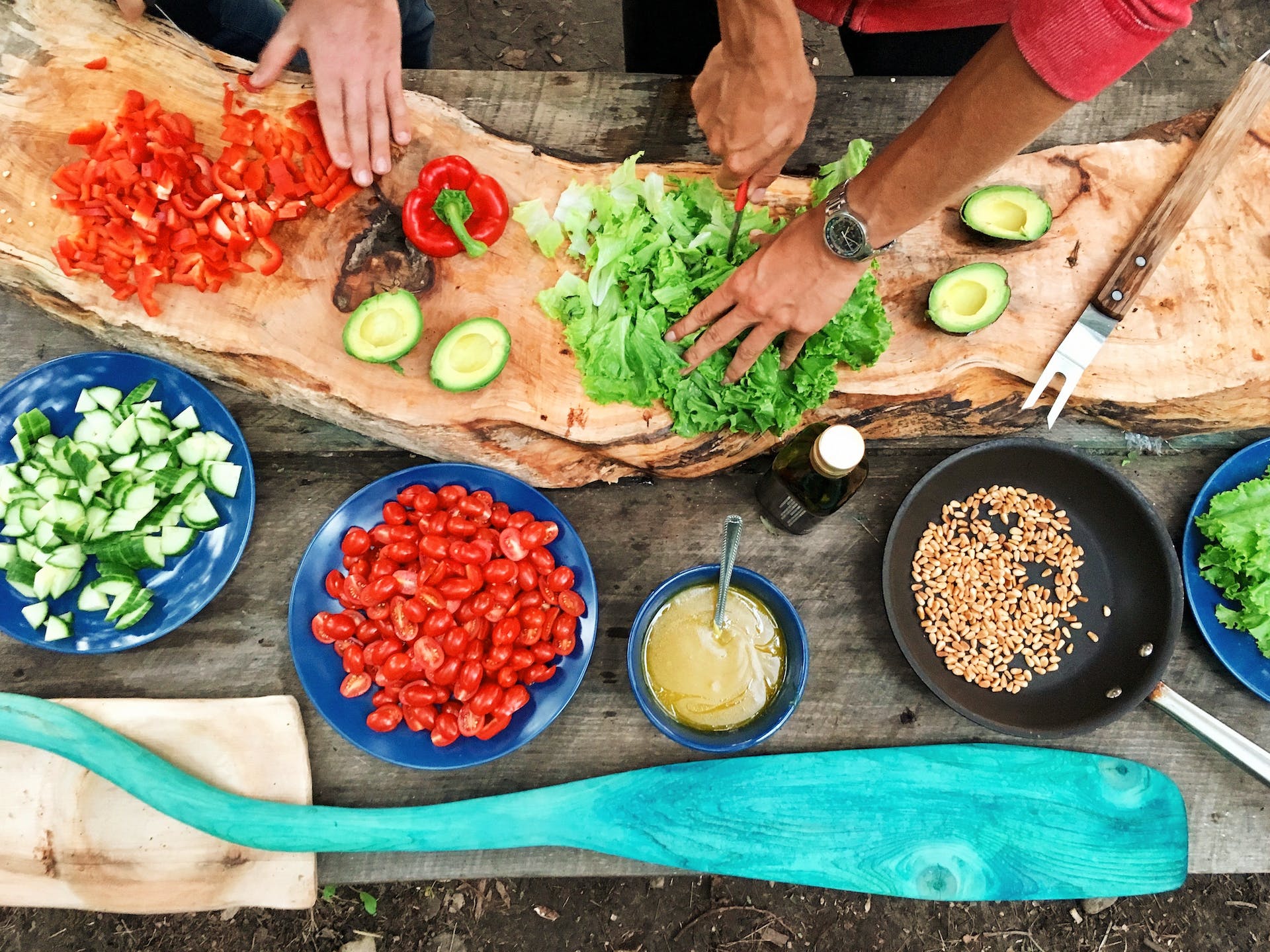Meal prep becomes the ultimate lifesaver in the chaos of your busy and hectic schedule. Eliminate the feeling of dread that comes with the question “What’s for dinner?”, especially after slogging through a long day of work, errands, chores, and every other demand on your time. Whether you want to meal prep for a whole week or just a few days, the benefits are the same: you’re apt to eat healthier more consistently, eat out less, and save money overall.
Follow this practical guide for meal prepping that walks you through the concepts and practice of meal prepping. These strategies will be of tremendous value for your busy and hectic lifestyle.
“Failure to plan is planning to fail.”
Whether this quote is attributable to Ben Franklin or Winston Churchill, the sentiment remains the same: meal prepping starts with meal planning. Don’t shotgun or shortchange this process. You shouldn’t shop for groceries if you haven’t planned your meals, and you can’t plan your meals until you set some time to actually develop a meal plan.
The success of meal planning and prepping begins with setting aside time to schedule all the necessary steps. Chiseling this into your busy schedule ensures you won’t overlook it, all but ensuring greater success. Consider incorporating meal planning into your routine, just like you do with other regular activities such as bill payments or doing laundry.
Involve your family in the process. Enlisting help from your family not only builds a support system but also introduces healthier foods into your meals together. You can even decide on a specific day during the week for dining out. Knowing this ahead of time allows you to plan your calorie intake around that meal, take some time to go over your social dining strategy, and enjoy the meal worry-free.
Master Meal Planning
Meal planning doesn’t mean having the same foods day after day. In fact, there’s a lot of flexibility in meal planning. If you choose, you can pre-cook full meals for specific days, batch-cook versatile ingredients, or plan a menu with ingredients ready for quick, delicious, healthy meals.
Develop your roster of go-to meals
A roster of go-to meals is the meals you already cook on a regular basis. These may be family favorites like spaghetti and meatballs or the new sheet pan meal everyone loves. As you’re putting your list together, keep your calorie and protein needs in mind. Take note of where you can swap out ingredients in existing recipes for healthier options. Also think about where you can introduce more vegetables or a side salad where you hadn’t included one before.
Using a roster of go-to meals keeps meal planning simple. You may think it could make mealtime boring if you have everything planned ahead of time. The truth is meal planning actually provides more flexibility. Once you become a meal prep master, you’ll see where you can squeeze in time to experiment with a new recipe you found online.
If the process sounds daunting, start by asking yourself these questions:
- What are my busiest days?
- Am I putting together a full meal or just some ingredients?
- What ingredients can be used in multiple meals?
- What food should be fresh and used within a couple of days?
- What foods freeze well?
Create your weekly meal plan
Now that you’ve got your go-to meals mapped out, it’s time to create your weekly meal plan. Think strategically about what goes into creating these meals, how much time you have available, who’s going to help, and what shortcuts you can take.
For example, it would be great to think you’re going to have roasted chicken and dumplings for dinner on Tuesday, but if Tuesday is a late day at work you’re shuttling kids around, you might not have time to pull that off. Instead, consider a meal that takes less prep time, has fewer ingredients, or was pre-cooked and frozen, and just needs to be defrosted, and save the chicken and dumplings for another day.
Begin by listing your busiest days and then ask yourself these questions:
- How much prep do my go-to meals need?
- Will I cook a whole meal from scratch?
- Will I have time to cook a pre-prepped meal?
- Do I need to have a full pre-made meal ready to reheat?
Finally, arrange and rearrange the meals based on those factors.
Create a grocery list and go shopping!
With your weekly list of meals all planned, it’s time to take stock of your fridge, freezer, cabinets, and pantry and determine what ingredients you have and what you need.
This is the opportune moment to explore healthier alternatives for certain ingredients. Consider swapping non-fat plain Greek yogurt for sour cream, opting for riced cauliflower as a nutritious substitute for white rice, or embracing ground chicken in lieu of ground beef. For more suggestions, refer to my list of Healthy Ingredient Swaps, available for download.
With your meal plan in mind, it’s time to create your shopping list. However, a few words of caution and some handy tips for your grocery shopping journey:
Create a comprehensive list: To avoid unnecessary purchases, make sure your list is detailed and buy only what’s on your list.
Don’t Shop Hungry: Grocery stores are configured to pump the delicious smells from the bakery to the front doors so your taste buds will drive you to make food choices.
Shop the Outer Perimeter: Start with the fresh foods on the outer perimeter, including veggies, fruits, whole grains, dairy, fish, and lean meats.
Don’t Buy Tempting Foods: Don’t tell yourself you will have the willpower to avoid it or will only eat “just one” once the food is in your house. Just don’t buy it at all.
By adhering to these guidelines, your grocery shopping becomes a strategic and efficient step in the meal prep process.
Meal Prepping: Unleashing the Magic
Meal prepping is where magic happens and transforms your meal planning process into a time-saving powerhouse. This involves taking your personally crafted meal plan and tackling some of the essential “prep steps” in advance to streamline the overall cooking process.
Based on your meal plan, you may be pre-chopping or pre-cooking specific ingredients. Or maybe you dive into batch cooking, preparing meals in advance for the entire week. Meal prepping may also include packing your food in grab-and-go containers. This way everything is pre-portioned and ready for action.
If your menu requires fresher foods or you have lean proteins that need marinating, you may find you need an extra day during the week to do some additional mini-prep activities.
As with meal planning, meal prepping can be a family activity as well. Involve the kids involved measuring ingredients and portioning snacks into grab-and-go containers. Delegate pre-chopping and mixing marinades to the teenagers. Family involvement promotes awareness of portion sizes, how healthier food choices can still make delicious meals and enjoy a sense of accomplishment with helping to create a family meal.
Streamlining the Meal Prepping Process: Practical Steps
Not sure where to start? Here are some suggestions that can help you delegate these tasks and streamline the prepping process.
- Refer to your weekly meal plan. This is your roadmap for the week.
- Identify foods suitable for batch cooking across multiple meals. This could be your favorite crock pot meal that do double duty as leftovers in a completely different meal.
- Determine which meals require prep-chopped ingredients for quick assembly, such as a head of broccoli, peppers or mushrooms.
- Identify meals needing pre-cooked ingredients for quick assembly, like chicken breast or health grains.
- Determine what meals need to be fully cooked for reheating. A pan of lasagna or baked ziti comes to mind here.
- Cook and pack all the ingredients and meals identified. Consider adding labels for the day of the week.
- Pre-chop any snacks and pack them in grab-and-go containers. I do this with berries every week.
Meal Prepping In Action
My weekdays are incredibly hectic, so all my planning and prepping happens on the weekend.
On Saturday morning, I’ll take stock of my kitchen and decide what my menu for the week will look like. For me, this means planning for breakfast, lunch, dinner, and snacks. I like my fruit and produce to be super fresh, so although Saturday is when I get my “big” shopping done, I know I’ll make a smaller trip during the week to pick up those fresher ingredients.
Sundays are my prep days, and I actually look forward to spending a few hours in the kitchen going through my goodies from the previous day’s shopping trip and creating several meals. While I shop for breakfast, lunch, and dinner, I do most of my actual prep for lunch and dinner. I work from home, and although I like to fool myself into thinking that I can make my lunch ‘while at work’, it doesn’t always work out that way. For this reason, I prepare salads, single bowl microwavable meals, or plan to reheat leftovers. Dinner prep includes cutting up broccoli stalks, making a batch of jasmine rice or quinoa, and marinating chicken thighs or chicken breasts.
For snacks, I portion out bowls of mixed berries, set aside my favorite yogurt or protein bars, or maybe portion out my favorite chili-flavored pistachios.
Final Thoughts
I’m not gonna lie…it took me a bit to get into the groove of meal planning and prepping. It’s harder in the summer months because I just want to be outside all day long. But the benefits are profound. I waste less food, save money, eat better, and don’t get to the point where I’m ravenous and making poor food choices. Meal prepping has become my secret weapon for a smoother, healthier lifestyle.

